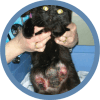Feline reproduction: problems and clinical challenges
- PMID: 21704900
- PMCID: PMC11107981
- DOI: 10.1016/j.jfms.2011.05.008
Feline reproduction: problems and clinical challenges
Abstract
Audience: Many veterinarians are closely involved with pedigree cat breeding and have become familiar with the unique characteristics of feline reproduction and breeding management. However, even veterinarians who do not have involvement with the pedigree cat fancy require a basic knowledge of the reproductive problems that are most likely to be encountered in working with non-breeding pet cats as well as stray and feral cats.
Clinical challenges: This article reviews reproductive problems and challenges in both sexes - namely, ovarian remnant syndrome, mammary fibroadenomatous hyperplasia, congenital anomalies of the reproductive tract and pregnancy diagnosis in the queen, and cryptorchidism and low libido in the tom.
Evidence base: Feline reproduction has not received the amount of investigation and attention that has been directed at canine reproduction. The result is that less data is available both for description of normal reproduction and for management of common problems. This article reviews most of the available evidence for the conditions discussed. Efforts should focus on making information more readily available to the practitioner and expanding the knowledge base in this important area of feline medicine.
Copyright © 2011 ISFM and AAFP. Published by Elsevier Ltd. All rights reserved.
Figures









Comment in
-
Deslorelin implants - a new choice in feline reproductive medicine.J Feline Med Surg. 2011 Nov;13(11):874-5. doi: 10.1016/j.jfms.2011.09.008. J Feline Med Surg. 2011. PMID: 22063211 Free PMC article. No abstract available.
Similar articles
-
Ovarian remnant syndrome and uterine stump pyometra in three queens.J Feline Med Surg. 2012 Dec;14(12):913-8. doi: 10.1177/1098612X12451373. Epub 2012 Jun 15. J Feline Med Surg. 2012. PMID: 22706446 Free PMC article.
-
Mammary fibroadenomatous hyperplasia in a young cat attributed to treatment with megestrol acetate.Can Vet J. 2003 Mar;44(3):227-9. Can Vet J. 2003. PMID: 12677692 Free PMC article.
-
Infertility In Toms: Clinical approach, experiences and challenges.J Feline Med Surg. 2022 Sep;24(9):837-846. doi: 10.1177/1098612X221118753. J Feline Med Surg. 2022. PMID: 36002138 Free PMC article. Review.
-
Reproduction of Domestic Cats in Laboratories, Catteries, and Feral Colonies: A Review.Top Companion Anim Med. 2023 Jul-Aug;55:100780. doi: 10.1016/j.tcam.2023.100780. Epub 2023 May 22. Top Companion Anim Med. 2023. PMID: 37225041 Review.
-
Feline breeding and pregnancy management: What is normal and when to intervene.J Feline Med Surg. 2022 Mar;24(3):221-231. doi: 10.1177/1098612X221079708. J Feline Med Surg. 2022. PMID: 35209770 Free PMC article. Review.
Cited by
-
Recurrent Feline Mammary Fibroadenomatous Hyperplasia in a Cat During Gestation.Vet Med Sci. 2024 Nov;10(6):e70060. doi: 10.1002/vms3.70060. Vet Med Sci. 2024. PMID: 39365140 Free PMC article.
-
Deslorelin implants - a new choice in feline reproductive medicine.J Feline Med Surg. 2011 Nov;13(11):874-5. doi: 10.1016/j.jfms.2011.09.008. J Feline Med Surg. 2011. PMID: 22063211 Free PMC article. No abstract available.
-
Polyorchidism in a cat.J Vet Diagn Invest. 2022 Nov;34(6):1020-1022. doi: 10.1177/10406387221127883. Epub 2022 Oct 1. J Vet Diagn Invest. 2022. PMID: 36184931 Free PMC article.
-
Ovarian remnant syndrome and uterine stump pyometra in three queens.J Feline Med Surg. 2012 Dec;14(12):913-8. doi: 10.1177/1098612X12451373. Epub 2012 Jun 15. J Feline Med Surg. 2012. PMID: 22706446 Free PMC article.
-
Disorders of sexual development in the cat: Current state of knowledge and diagnostic approach.J Feline Med Surg. 2022 Mar;24(3):257-265. doi: 10.1177/1098612X221079711. J Feline Med Surg. 2022. PMID: 35209773 Free PMC article. Review.
References
-
- . Miller DM. Ovarian remnant syndrome in dogs and cats: 46 cases (1988–1992). J Vet Diagn Invest 1995; 7: 572–74. - PubMed
-
- . DeNardo G, Becker K, Brown N, et al.. Ovarian remnant syndrome: revascularization of free-floating ovarian tissue in the feline abdominal cavity. J Am Anim Hosp Assoc 2001; 37: 290–96. - PubMed
-
- . Ball R, Birchard S, May R, et al.. Ovarian remnant syndrome in dogs and cats: 21 cases (2000–2007). J Am Vet Med Assoc 2010; 236: 548–53. - PubMed
-
- . Axner E, Gustavsson T, Strom Holst B. Estradiol measurement after GnRH-stimulation as a method to diagnose the presence of ovaries in the female domestic cat. Theriogenol 2008; 70: 186–91. - PubMed
-
- . Scebra L, Griffin B. Evaluation of a commercially available luteinizing hormone test to distinguish between ovariectomized and sexually intact queens [abstract]. J Vet Intern Med 2003; 17; 432. - PubMed
Publication types
MeSH terms
LinkOut - more resources
Full Text Sources
Miscellaneous

